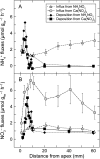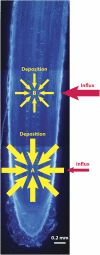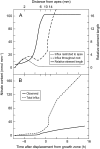Deposition of ammonium and nitrate in the roots of maize seedlings supplied with different nitrogen salts
- PMID: 22213811
- PMCID: PMC3295394
- DOI: 10.1093/jxb/err410
Deposition of ammonium and nitrate in the roots of maize seedlings supplied with different nitrogen salts
Abstract
This study measured total osmolarity and concentrations of NH(4)(+), NO(3)(-), K(+), soluble carbohydrates, and organic acids in maize seminal roots as a function of distance from the apex, and NH(4)(+) and NO(3)(-) in xylem sap for plants receiving NH(4)(+) or NO(3)(-) as a sole N-source, NH(4)(+) plus NO(3)(-), or no nitrogen at all. The disparity between net deposition rates and net exogenous influx of NH(4)(+) indicated that growing cells imported NH(4)(+) from more mature tissue, whereas more mature root tissues assimilated or translocated a portion of the NH(4)(+) absorbed. Net root NO(3)(-) influx under Ca(NO(3))(2) nutrition was adequate to account for pools found in the growth zone and provided twice as much as was deposited locally throughout the non-growing tissue. In contrast, net root NO(3)(-) influx under NH(4)NO(3) was less than the local deposition rate in the growth zone, indicating that additional NO(3)(-) was imported or metabolically produced. The profile of NO(3)(-) deposition rate in the growth zone, however, was similar for the plants receiving Ca(NO(3))(2) or NH(4)NO(3). These results suggest that NO(3)(-) may serve a major role as an osmoticant for supporting root elongation in the basal part of the growth zone and maintaining root function in the young mature tissues.
Figures









Similar articles
-
Exogenous diethyl aminoethyl hexanoate ameliorates low temperature stress by improving nitrogen metabolism in maize seedlings.PLoS One. 2020 Apr 30;15(4):e0232294. doi: 10.1371/journal.pone.0232294. eCollection 2020. PLoS One. 2020. PMID: 32353025 Free PMC article.
-
Effect of exogenous ammonium gluconate on growth, ion flux and antioxidant enzymes of maize (Zea Mays L.) seedlings under NaCl stress.Plant Biol (Stuttg). 2019 Jul;21(4):643-651. doi: 10.1111/plb.12963. Epub 2019 Feb 15. Plant Biol (Stuttg). 2019. PMID: 30663821
-
NO homeostasis is a key regulator of early nitrate perception and root elongation in maize.J Exp Bot. 2014 Jan;65(1):185-200. doi: 10.1093/jxb/ert358. Epub 2013 Nov 12. J Exp Bot. 2014. PMID: 24220653 Free PMC article.
-
Nitrate signalling to stomata and growing leaves: interactions with soil drying, ABA, and xylem sap pH in maize.J Exp Bot. 2007;58(7):1705-16. doi: 10.1093/jxb/erm021. Epub 2007 Mar 20. J Exp Bot. 2007. PMID: 17374875
-
Multiple routes communicating nitrogen availability from roots to shoots: a signal transduction pathway mediated by cytokinin.J Exp Bot. 2002 Apr;53(370):971-7. doi: 10.1093/jexbot/53.370.971. J Exp Bot. 2002. PMID: 11912239 Review.
Cited by
-
Grafting improves tomato yield under low nitrogen conditions by enhancing nitrogen metabolism in plants.Protoplasma. 2021 Sep;258(5):1077-1089. doi: 10.1007/s00709-021-01623-3. Epub 2021 Feb 22. Protoplasma. 2021. PMID: 33616734
-
Elevated Carbon Dioxide and Chronic Warming Together Decrease Nitrogen Uptake Rate, Net Translocation, and Assimilation in Tomato.Plants (Basel). 2021 Apr 8;10(4):722. doi: 10.3390/plants10040722. Plants (Basel). 2021. PMID: 33917687 Free PMC article.
-
Photorespiration and nitrate assimilation: a major intersection between plant carbon and nitrogen.Photosynth Res. 2015 Feb;123(2):117-28. doi: 10.1007/s11120-014-0056-y. Epub 2014 Nov 4. Photosynth Res. 2015. PMID: 25366830 Review.
-
Induced leaf intercellular CO₂, photosynthesis, potassium and nitrate retention and strawberry early fruit formation under macronutrient limitation.Photosynth Res. 2013 Jul;115(2-3):101-14. doi: 10.1007/s11120-013-9832-3. Epub 2013 May 18. Photosynth Res. 2013. PMID: 23686470
-
Soil microbial diversity and functional capacity associated with the production of edible mushroom Stropharia rugosoannulata in croplands.PeerJ. 2022 Oct 3;10:e14130. doi: 10.7717/peerj.14130. eCollection 2022. PeerJ. 2022. PMID: 36213510 Free PMC article.
References
-
- Allen S. Intracellular pH regulation in plants. ISI Atlas of Science: Animal and Plant Sciences. 1988;1:283–288.
-
- Andrews M. The partitioning of nitrate assimilation between root and shoot of higher plants. Plant, Cell and Environment. 1986;9:511–519.
-
- Bloom AJ. Interactions between inorganic nitrogen nutrition and root development. Zeitshrift für Pflanzennährung und Bodenkunde. 1997;160:253–259.
-
- Bloom AJ, Burger M, Asensio JSR, Cousins AB. Carbon dioxide enrichment inhibits nitrate assimilation in wheat and Arabidopsis. Science. 2010;328:899–903. - PubMed

